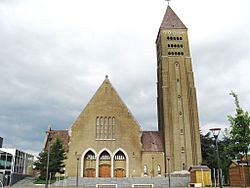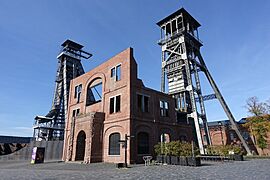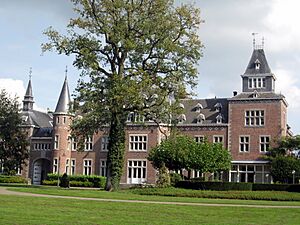Genk facts for kids
Quick facts for kids
Genk
|
|||
|---|---|---|---|

Church of Saint Martin
|
|||
|
|||
| Country | Belgium | ||
| Community | Flemish Community | ||
| Region | Flemish Region | ||
| Province | Limburg | ||
| Arrondissement | Hasselt | ||
| Area | |||
| • Total | 87.85 km2 (33.92 sq mi) | ||
| Population
(2018-01-01)Lua error in Module:Wd at line 1575: attempt to index field 'wikibase' (a nil value).
|
|||
| • Total | Lua error in Module:Wd at line 1,575: attempt to index field 'wikibase' (a nil value). | ||
| Postal codes |
3600
|
||
| Area codes | 089 | ||
| Website | www.genk.be | ||
Genk is a city and municipality in Belgium. It is located in the province of Limburg, close to the city of Hasselt. Genk is known as an important industrial city in Flanders. It sits along the Albert Canal, a waterway connecting major cities like Antwerp and Liège.
Contents
Genk's Past: A Journey Through Time
![]() County of Loon 1108–1366
County of Loon 1108–1366
![]() Prince-Bishopric of Liège 1366–1789
Prince-Bishopric of Liège 1366–1789
![]() Republic of Liège 1789–1791
Republic of Liège 1789–1791
![]() Prince-Bishopric of Liège 1791–1795
Prince-Bishopric of Liège 1791–1795
![]() French Republic 1795–1804
French Republic 1795–1804
![]() French Empire 1804–1815
French Empire 1804–1815
![]() Kingdom of the Netherlands 1815–1830
Kingdom of the Netherlands 1815–1830
![]() Kingdom of Belgium 1830–present
Kingdom of Belgium 1830–present
Early Beginnings: Celtic Roots and First Mentions
Genk likely started as a small village built by the Celts. Around the 10th century, Christianity arrived in the area. Evidence of an old wooden church from that time has been found. The first time Genk was written about was in 1108. It was called Geneche in a document that gave the land to the Abbey of Rolduc. For many years, Genk was part of the County of Loon. In 1365, it became part of the Prince-Bishopric of Liège.
The 19th Century: A Quiet Artist Village
While other parts of Belgium became industrial, Limburg changed slowly. Genk remained a small, peaceful village. By 1900, only about 2,000 people lived there. This quiet setting attracted many landscape painters and writers, like Neel Doff. Genk became a popular spot for artists to paint outdoors. More than 400 landscape painters visited the area.
The 20th Century: Coal and Growth
A big change happened in 1901 when André Dumont discovered a lot of coal nearby. Soon, coal was also found in Genk. After World War I, many people moved to Genk. Both Belgians and people from other countries came to work. Genk quickly grew into the largest town in Limburg after Hasselt. Its population reached 70,000 people.
However, the coal mines eventually closed. The Zwartberg mine closed in 1966. By the late 1980s, the Winterslag and Waterschei mines also shut down. Genk then had to find new ways to create jobs. New industries developed, especially along the Albert Canal and highways. In 2000, Genk officially became a city.
Genk's Economy: From Coal to Creativity
Genk is a major industrial hub in the Limburg province. It provides over 45,000 jobs, making it a very important economic city in Flanders.
The Impact of Coal Mining
In 1900, Genk was a small village with about 2,000 people. It was known for its beautiful nature, which artists loved to paint. The discovery of coal in 1901 changed everything. Three large coal mines were built: Zwartberg, Waterschei, and Winterslag (which is now called C-mine). Because of the mines, Genk's population grew very fast. Today, about 65,000 people live in Genk, coming from 107 different backgrounds.
The mines had successful years, but they eventually closed. The Zwartberg mine closed in 1966. Winterslag (C-mine) closed in 1986, and Waterschei in 1987.
Ford Factory and New Industries
For a long time, the Genk Body & Assembly factory of Ford Motor Company was Genk's biggest employer. It employed about 5,000 people. The factory built popular cars like the Ford Mondeo, Ford Galaxy, and Ford S-MAX. However, this factory closed in 2014.
C-Mine: A Hub for Creativity
After the mines closed, Genk looked for new uses for the large mine sites. In 2000, the idea came up to turn the old Winterslag coal mine into a creative center. The city bought the site in 2001, and it was named "C-mine" in 2005.
C-mine focuses on four main areas:
- Education: It has a college with many artistic study programs.
- Creative Economy: It helps young businesses grow.
- Creative Recreation: It offers fun and creative activities.
- Artistic Creation and Presentation: It supports art and performances.
C-mine now has a cultural center, a design center, a cinema, and the C-mine expedition. It has created 330 jobs in 42 companies and organizations. About 200 of these jobs are in creative fields. Every day, C-mine produces games, apps, websites, TV sets, drones, light shows, and stage productions. It is a place where creative people make amazing things.
- Companies at C-Mine:
- E-nventors Lab / C-mine crib: This is a research and development department that explores new technologies.
Places to Visit in Genk
Genk has many interesting places to explore, blending its industrial past with beautiful green spaces.
- Bokrijk: This is Genk's biggest tourist attraction. It is an open-air museum with old buildings from the 17th to 19th centuries. These buildings were moved here from all over Flanders. In summer, actors bring history to life with re-enactment events.
- Hoge Kempen National Park: Genk is one of the main entry points to this park. It was the first National Park in Flanders, opening in 2006.
- Old Coal Mines: You can visit the sites of the old coal mines at Zwartberg, Waterschei, and Winterslag. These sites have huge black mountains called slag heaps, made from dug-up soil and coal waste. Some of the mine buildings and old houses can also be explored.
- "The Green City": Even with its industrial history, Genk is called 'De Groene Stad' (The Green City). It has a nature reserve called "De Maten." There is also a large recreation area called Kattevennen, which includes the Europlanetarium. Other green areas and Bokrijk add to its green charm.
- Sundial Park: On sunny days, you can visit the Sundial Park (Dutch: Zonnewijzerpark).
- Museum Emile Van Doren: This museum tells the story of the landscape painters who visited Genk between 1840 and 1940.
- Europlanetarium Genk: This center has a planetarium and an observatory where you can learn about space.
Exciting Events in Genk
Genk used to host the Motives Festival in November, celebrating new jazz sounds. It featured artists like Esbjörn Svensson Trio and Joshua Redman. Another music event, Genk on Stage, took place over three days in summer, but it is no longer celebrated.
Genk also has many traditional events:
- Carnival: A colorful carnival happens around Ash Wednesday.
- May Celebrations: These include the crowning of a May Queen, a parade with flowers, and a big fireworks show.
- Saint Martin Procession: This procession honors Saint Martin of Tours, a very popular saint in Flanders.
- Manifesta: In 2012, Genk hosted Manifesta, a major European art event. It is one of Europe's most important art shows, like the Venice Biennial.
Getting Around Genk
Genk has good transportation options. Besides the Albert Canal, there is a train service to Hasselt. A small airport (EBZW) is about 6 kilometers (4 miles) northeast of the city center. De Lijn is the only bus company that provides public transport within Genk.
Sports in Genk
Genk is home to a successful football club, KRC Genk. They joined the top Belgian football league in 1996. Since then, they have become one of Belgium's best clubs. KRC Genk won the highest football league in 1999, 2002, 2011, and 2019. They also won the Belgian Cup in 1998, 2000, 2009, 2013, and 2021.
Their home stadium, the Luminus Arena (also known as Fenix Stadium and Cristal Arena), can hold 25,500 fans. It is now a major center for both sports and other events. In the 2016–2017 season, KRC Genk reached the quarter-finals of the UEFA Europa League. They beat another Belgian team, K.A.A. Gent, with one game ending in a 5–2 win.
Karting Genk is a famous kart racing track. In 2011, it hosted the Karting World Championship.
Genk's Diverse Population
Genk is a very diverse city. About 24% of its residents come from other countries. They represent about 85 different nationalities. Many people are from Italy, Turkey, and Greece. Genk is believed to have the largest Turkish community in Belgium compared to its total population.
Notable People from Genk
- Neel Doff, writer (1858–1942)
- Jacques Germeaux, former politician and senator (born 1956)
- Peter Vanhoutte, former politician and MP (born 1956)
- Martin Margiela, fashion designer (born 1957)
- Jo Vandeurzen, politician and Minister of Health (born 1958)
- Dirk Medved, football defender (born 1968)
- Ronny Gaspercic, football goalkeeper (born 1969)
- Karel Geraerts, footballer (born 1982)
- Benjamin De Ceulaer, footballer (born 1983)
- Siglo XX, 1980s Coldwave band
- Claudio Desolati, Italian footballer (born 1955)
Sister Cities
Genk has special connections with these cities around the world:
 Francistown, Botswana (since 2004)
Francistown, Botswana (since 2004) Cieszyn, Poland
Cieszyn, Poland Isparta, Turkey
Isparta, Turkey San Giovanni in Fiore, Italy
San Giovanni in Fiore, Italy
Images for kids
See also
 In Spanish: Genk para niños
In Spanish: Genk para niños












